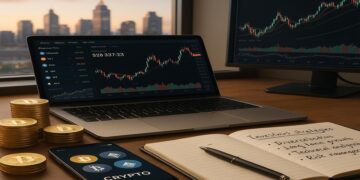
The influence of monetary policy on the appreciation of the dollar and its economic consequences
Monetary policy significantly influences the dollar's appreciation, impacting inflation, interest rates, and economic growth. Higher interest rates attract foreign investment, while quantitative easing can initially weaken the dollar. This complex relationship shapes global trade dynamics and foreign investment, highlighting the importance of understanding these economic consequences.

Microfinance as a Tool for Economic Development: Case Studies in the USA
Microfinance enhances economic development in the USA by promoting financial inclusion and empowering underserved communities, particularly women entrepreneurs. While it addresses credit accessibility through tailored loans and education, challenges like high operational costs and borrower over-indebtedness threaten its sustainability. Strategic collaborations are essential for maximizing its impact.

The impact of climate change on financial industries: risks and opportunities for American investors
Climate change poses significant risks and opportunities for American investors in the financial sector. As environmental shifts reshape industries, investors must adapt strategies to navigate emerging risks while capitalizing on sustainable investments, such as green bonds and renewable energy, which promise both financial returns and alignment with ecological responsibilities.

Sustainable Investments: How the Green Economy is Shaping the Financial Future of the U.S.
The shift towards sustainable investments is transforming the U.S. financial landscape, driven by regulatory support, consumer demand, and technological advancements. As sectors like renewable energy and sustainable agriculture thrive, investors increasingly recognize the potential for strong returns alongside positive environmental and social impacts, paving the way for a robust green economy.

The future of remote work and its economic implications: how companies are adapting and the effects on productivity
The rise of remote work is reshaping corporate strategies, enhancing flexibility, and enabling cost savings. Companies are tapping into diverse talent pools while facing challenges in communication and productivity measurement. Balancing economic benefits with employee well-being and adaptability will be crucial for future success in this evolving landscape.

The relationship between student debt and economic growth: challenges faced by young professionals in the US
The escalating student debt crisis in the US, now exceeding $1.7 trillion, significantly hinders young professionals' financial stability and economic growth. High debt levels lead to delayed consumer spending, reduced entrepreneurial activity, and impacts on homeownership and retirement savings, posing long-term challenges for economic mobility and overall productivity.

The impact of artificial intelligence on the efficiency of financial markets and its economic implications in the USA
Artificial intelligence is transforming the efficiency of financial markets in the USA, enhancing decision-making, risk assessment, and accessibility for investors. While it drives profitability and democratizes investment opportunities, AI introduces challenges like market volatility and regulatory concerns, necessitating careful oversight to ensure economic stability and equity.

Cryptocurrencies and Their Regulation: Challenges for Economic Stability in the USA
The rise of cryptocurrencies has introduced significant challenges for regulatory frameworks in the USA, impacting economic stability. Issues such as market volatility, fraud risks, and tax compliance complicate investor confidence. A cohesive regulatory approach is essential to balance innovation while safeguarding the integrity of financial systems amidst evolving digital landscapes.

Investment Strategies in Cryptocurrencies: Risks and Opportunities for New Investors
New cryptocurrency investors must understand the market's volatility, regulatory landscape, and diverse investment options. Effective strategies, such as portfolio diversification and risk management, are crucial for success. By conducting thorough research and employing disciplined trading practices, investors can navigate risks and seize opportunities in this ever-evolving financial frontier.

The Benefits of Investing in Green Bonds: How to Contribute to a Sustainable and Profitable Future
Green bonds offer a unique investment opportunity, combining environmental sustainability with competitive financial returns. By funding projects aimed at combating climate change, these bonds attract diverse investors seeking both stable income and social impact. As demand rises, integrating green bonds into portfolios promotes a sustainable future while enhancing financial performance.